

Discover more from Frederick R. Smith Speaks
The Great Greenbrier Resort
The Greenbrier Resort is a historic and award-winning venue located in the Allegheny Mountains of West Virginia. It is known for its elegant architecture, scenic landscape, and rich history.
The History of The Greenbrier: America’s Resort is a colorful and comprehensive chronicle of the resort’s growth and development over the years. More than that, it is an intriguing study of fashionable society's history. Here the changing rituals of American social life are on lavish display: Southern aristocrats gathering about the Springhouse back before the Civil War engaged in politics, romance, and “taking the waters;” beautiful and witty belles dancing at elaborate cotillions on summer evenings in the ballroom of the Old White Hotel; prominent high-society figures strolling into The Greenbrier’s chandeliered dining rooms after stepping off their private railroad cars; presidents and professional golfers working on their best games against the legendary Sam Snead.
Robert S. Conte, from The History of the Greenbrier America’s Resort
Foreword
It is an honor to present another “hands-on” historical essay about an essential element of American history. An exquisite vacation with my wife at the Greenbrier Resort in March 2023 made this installment possible. It was a joy to partake in the many amenities at the resort. The pleasures included entertainment, fine shopping, a mineral water spa, luxurious meals, and a tour of the “bunker.” This essay about my visit includes my favorite topics: history, railroading, and intrigue. Enjoy!
Introduction
The Greenbrier Resort is a historic and luxurious destination that has been operating since 1778. It is in White Sulphur Springs, West Virginia. The resort is in the scenic Allegheny Mountains. It boasts an 11,000-acre property that offers a variety of activities and amenities for its guests. The resort’s history is rich and eclectic. It served as a healing spa, a social hub, a military hospital, a secret bunker, and a presidential retreat over the years. The resort has hosted many notable figures. Presidents, royalty, celebrities, and diplomats, enjoyed its elegant architecture. Luxuries include exquisite cuisine and legendary hospitality. The Greenbrier Resort is a National Historic Landmark. It attracts visitors from around the world who seek to experience its timeless charm and unparalleled service.
Historical Overview
The Greenbrier Resort, as we know it today, did not exist during the Civil War. Instead, the resort’s property now stands as the site of a smaller venue known as the White Sulphur Springs hotel, which played a significant role in the war.
The White Sulphur Springs hotel was a Confederate hospital during the Civil War. It helped to treat soldiers from both sides. The hotel’s ballroom served as a surgical ward. Tents and temporary structures accommodated the influx of patients. In 1862, Union troops took over and used it as a military hospital. During this time, the hotel gained its reputation as a place of healing. Soldiers and civilians flocked to the area to take advantage of the therapeutic waters of the nearby springs.
After the Civil War, the White Sulphur Springs hotel was rebuilt and expanded to become the “Old White Hotel.” Its role as a healing site and rejuvenation remained essential to its identity. In November 1922, the Old White failed a fire inspection and was torn down. A new central Greenbrier structure was built and expanded in 1930. The resort continues to attract guests seeking rest, relaxation, and renewal.
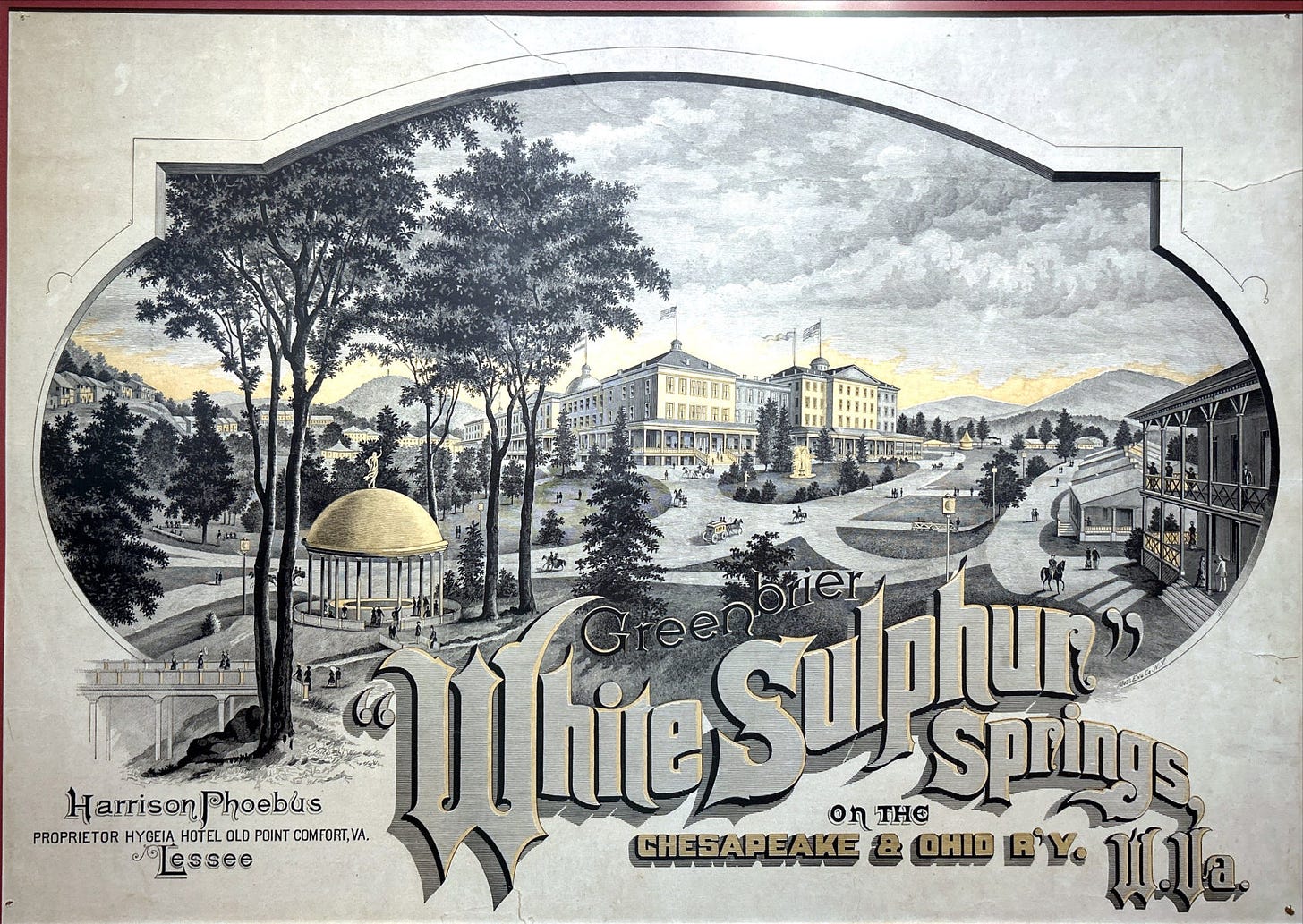
Today, visitors to the Greenbrier can still see evidence of the hotel’s Civil War past, including photographs and artifacts. It serves as a reminder of the sacrifices made by soldiers and civilians. It is a tribute to one of the most tumultuous periods in American history.
During World War II, the U.S. Government purchased the resort as a hospital and rehabilitation center for wounded soldiers. After the war, the C&O regained ownership and operated it as a luxury resort again. The Greenbrier has a long and rich history of hosting presidents, celebrities, and business leaders since its opening in 1910. The Chesapeake and Ohio Railway built the resort as we know it today to attract passengers to its trains.
Ownership History
The location we know today at the Greenbrier Restot had several owners over the centuries. Before 1910, the resort was owned by several different individuals and families.
The Chesapeake and Ohio (C&O) Railway Company owned the Greenbrier Resort from 1910 until 1972. During that time, it transformed the property into one of the most luxurious and celebrated resorts in the United States. In 1910, the C&O Railway Company purchased the Greenbrier to expand its operations and promote tourism in West Virginia. The company invested in the resort. It added new facilities and amenities to attract wealthy guests nationwide.
Under the C&O’s ownership, the Greenbrier became renowned for its elegance and sophistication. Amenities included high-end dining, entertainment, and recreational options. The resort’s championship golf course attracted golfers worldwide. At the same time, its world-class spa and mineral baths offer guests a chance to relax and rejuvenate.
From late 1941 to July 1942, the C&O allowed the U.S. government to contract with the Greenbrier to manage temporary housing for foreign diplomats. After that, the C&O, under pressure from the War Powers Act, sold the resort to the U.S. Army for use as a hospital. It was renamed “The Ashford General Hospital.”
The C&O regained ownership after the war (see “U.S. Government use and Ownership” below). The C&O and its successors, Chessie System and CSX Corporation, owned the resort as a subsidiary for almost a century until 2009. That year, the resort filed for bankruptcy protection due to heavy losses caused by the economic downturn. A West Virginia entrepreneur named Jim Justice, who had a lifelong admiration for the resort, bought it from CSX for $20 million. He invested millions of dollars in renovating and expanding the resort. The notable addition is a casino.
Justice also became the governor of West Virginia in 2017. That created a potential conflict of interest as he oversees state policies that affect his business. He still owns the resort today through his company Justice Family Group.
U.S. Government use and Ownership
In 1942, as the war raged in Europe, the U.S. government held diplomats from Axis powers living in the United States. Many of these individuals ended up in makeshift centers, often in cramped and uncomfortable conditions. The U.S. government chose the Greenbrier Resort to recognize the need for a more suitable location. From late 1941 to July 1942, the resort’s luxurious accommodations and extensive grounds made it an ideal location. It housed high-ranking officials and their families from Axis powers such as Germany, Italy, and Japan.
The detained diplomats lived in the Greenbrier’s cottages and other buildings. The accommodations were far more comfortable than those found in traditional detention centers. Diplomats were still monitored and restricted in their movements. Despite the restrictions, many diplomats enjoyed the resort’s amenities. They were also allowed to receive visits from family members and even hold social events, such as dances and parties.
The Greenbrier resumed operation as a resort for six weeks after the last diplomats departed. In September 1942, the U.S. Army purchased the Greenbrier and converted it into a hospital to treat soldiers wounded in the war. The resort’s facilities provided soldiers with medical care, rehabilitation, and physical therapy.
During this time, the Greenbrier was a bustling hub of activity, with hundreds of soldiers and medical staff moving in and out of the resort daily. Despite the severe nature of the work there, the Greenbrier retained much of its elegance and charm. Soldiers and medical staff enjoyed the resort’s amenities while not working.
After the war ended, the Greenbrier returned to the private ownership of the C&O Railroad and resumed its role as a luxury resort. The time it spent as a government facility remains an essential chapter in the history of the Greenbrier. It serves as a reminder of the sacrifices made by American soldiers during World War II.
The Elegance
The Greenbrier Resort is more than a beautiful place to stay; it’s also a hub of activity and entertainment. Guests can enjoy various activities, from golfing on the resort’s world-renowned golf course. They can relax at the spa or swim in one of the pools. The Greenbrier also offers various dining options. Options range from casual to fine dining, with menus highlighting West Virginia’s best. Our first night’s meal was at the Prime 44, rivaling well-known high-end restaurants like Morton’s steak house.
The Greenbrier’s architecture combines classic and modern styles. That included Georgian, Tudor, and French Renaissance elements. Its signature white exterior, red roofs, and green shutters give it a timeless, elegant look. It has captivated visitors for generations. The resort boasts over 700 guest rooms, 50 suites, and 33 cottages. All structures have furnishings with luxurious amenities.
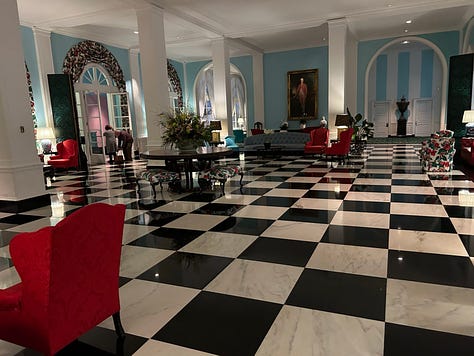
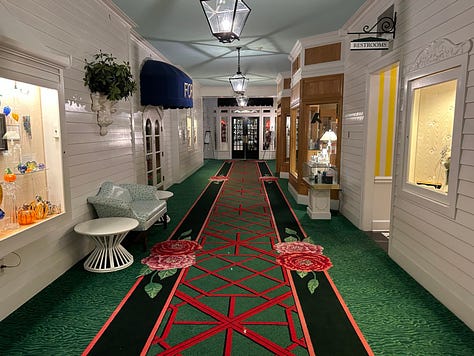
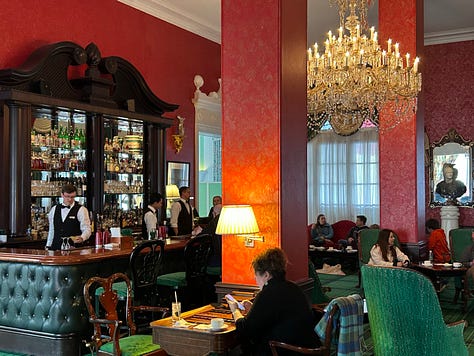
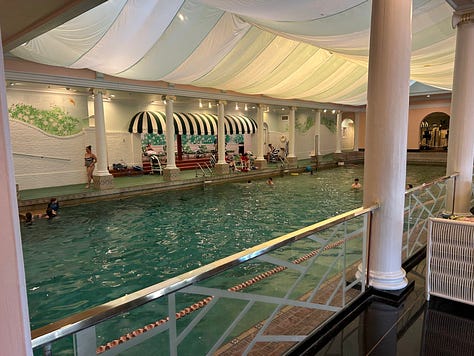
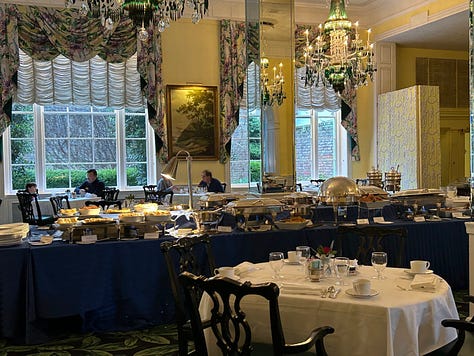
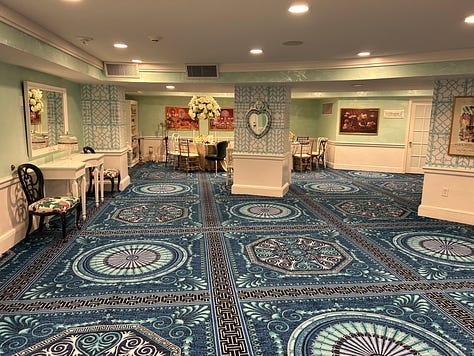
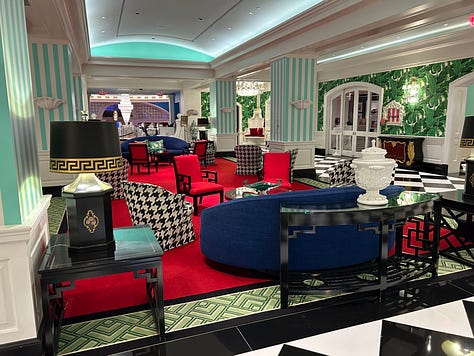
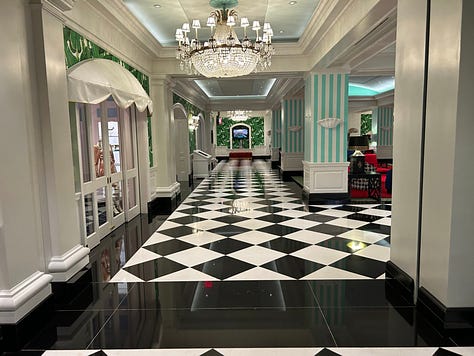
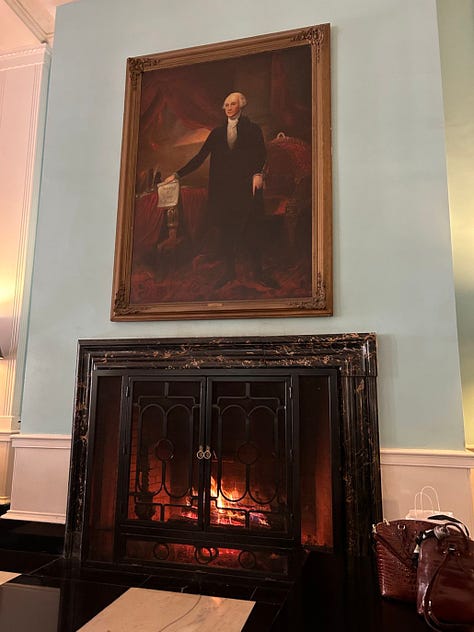
The Bunker
The Greenbrier Bunker, also known as the Greenbrier Cold War Relocation Center, is a fascinating piece of American history. The bunker is beneath the Greenbrier Resort. It served as a secret government relocation facility during a nuclear attack. Construction of the bunker began in the late 1950s, during the height of the Cold War. The bunker is under the West Virginia Wing of the Greenbrier Resort. It stood ready to house members of the U.S. Congress and other government officials in the event of a nuclear attack.
The bunker was a massive underground complex covering more than 100,000 square feet. It included dormitories, a medical clinic, a communications center, a cafeteria, and a television studio. Completely self-sufficient, the bunker has its own power plant, water supply, and air filtration system.
Constructed occurred between 1958 and 1961 under President Dwight D. Eisenhower’s direction. It was given the code name “Project Greek Island.” Eisenhower wanted to ensure the continuity of government in a worst-case scenario. The bunker had two levels and covered an area of 112,544 square feet. It had rooms for House and Senate chambers, dormitories, offices, a cafeteria, a clinic, a power plant, and a decontamination area. Stocks included food, water, medicine, and other supplies to sustain 535 members of Congress and their staff for up to 60 days. A covert team of government employees posed as hotel workers and technicians to maintain the bunker.
The Greenbrier Bunker remained a secret for decades. Only a select few government officials and employees of the Greenbrier Resort knew of its existence. The bunker was ready for use but never needed. The public and most members of Congress were unaware for over three decades. On May 31, 1992, The Washington Post’s Ted Gup broke the story of the bunker’s existence.1 The report exposed a government secret hidden from the public for decades, revealing the extent of the government’s preparations for a nuclear war. For more about the controversy surrounding Gup’s expose of the “bunker mentality,” please click here.
As a result, of the expose, the government declassified the bunker, decommissioned it in 1995, and later opened it to the public as a museum. Touring the facility, you can see firsthand the eerie, Cold War-era artifacts preserved within its walls. As I can attest, it is worth the $40.00 admission fee to partake in the guided tour. Photography prohibited! But of course, the Internet has plenty of pictures to look at and this video.
Honoring George Washington
George Washington played a significant role in the early development of the Chesapeake and Ohio Canal Company (C&OCC). Formed in 1825, the C&OCC worked to build a canal linking the Potomac River to the Ohio River.
Washington advocated a canal linking the eastern seaboard with the western frontier. It provided a more efficient means of transporting goods and people than the existing system of roads and rivers. He believed the canal would benefit commerce and strengthen the nation’s unity. It connected its eastern and western regions.
Washington’s vision influenced the formation of the C&OCC, and he became an honorary member of the company’s board of directors in 1785. He continued to advocate for the canal’s construction throughout his life. He provided financial and logistical support for the project.
After Washington’s death (1799), his vision for the canal blossomed, with the canal’s construction starting in 1828. Completed in 1850, the C&OCC operated for several decades. It provided a vital transportation link between the eastern and western regions of the United States. The canal faced many challenges, including railroad competition and declining freight traffic. It closed in 1924.
The C&OCC was a forerunner of the Chesapeake and Ohio Railway (C&O), built in the late 19th century to replace the canal. The C&O emerged as a dominant force in the region. Much of the railroad followed the same route as the canal and utilized the same infrastructure. It provided faster and more efficient transportation of goods and people than the canal had ever achieved.
The C&O played a significant role in the region’s economic development. It provided a vital link between the coal mines of West Virginia and the markets of the eastern United States. The railroad also played a crucial role in developing tourism in the region. It served the Greenbrier Resort and other destinations along its route.
The Greenbrier, in grand style, represents George Washington with his bust, the main lobby, and more (stay tuned).
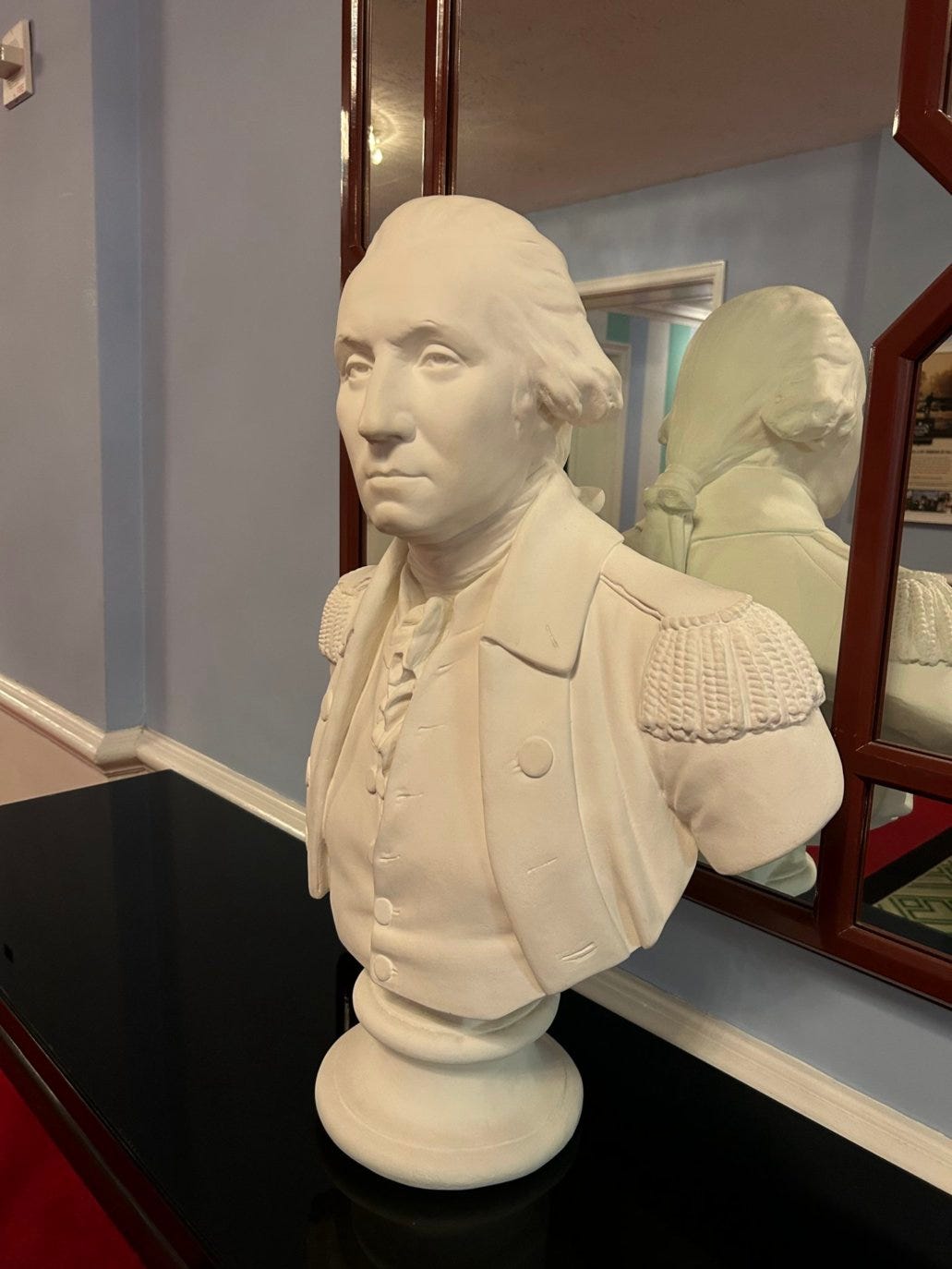
The George Washington train, operated by the C&O, was one of the most luxurious and prestigious passenger trains in the United States from 1932 to 1971. The train was named after the first president of the United States. It was an important symbol of American innovation and progress during significant economic and social change.
The C&O George Washington train traveled on a route that connected Cincinnati, Ohio, with Newport News, Virginia, passing through several major cities and towns along the way. The train made stops in Charlottesville, Richmond, and Newport News in Virginia, White Sulfur Springs and Huntington, West Virginia, and Ashland, Kentucky. Additionally, the train traveled through the scenic Shenandoah Valley region of Virginia and crossed the Appalachian Mountains, offering passengers breathtaking views of the surrounding landscape.
The George Washington train offered passengers the ultimate comfort and convenience, with luxurious accommodations that included private sleeping compartments, gourmet dining, and even a barbershop. The train was also equipped with state-of-the-art technology, including air conditioning and radio communications, which were cutting-edge features at the time.
White Sulphur Springs is a station stop on Amtrak’s “Cardinal” route today. The former station building is now the Greenbrier Resort’s Christmas gift shop. The station’s red-and-white “candy cane” paint job makes it unique among other Amtrak stations. Since the late 1980s, Amtrak passengers have used the adjacent covered platform. No Amtrak agent or station services (ticketing, checked baggage, etc.) are available at this station, and all tickets must be purchased in advance.
The Artifacts
One of the most notable artifacts at the Greenbrier is the Presidential Suite. It is the accommodation of choice for many U.S. presidents. The suite features original furnishings from the 1930s and 1940s, including a chandelier that once hung in the White House’s East Room.
The Greenbrier’s history reflects its decor. Many paintings, sculptures, and other works of art adorn the resort’s walls and public spaces. Many of these pieces reflect the resort’s rich history and the surrounding area’s natural beauty. The more notable artifacts include paintings by Gilbert Stuart and his daughter Jane Stuart.
Gilbert Charles Stuart (1755-1828) was a prominent American painter specializing in portraits. He was born in Rhode Island Colony and showed an early talent for drawing and painting. He studied with Scottish painter Cosmo Alexander in America and England, where he developed his skills and reputation. He returned to America in 1793 and settled in Philadelphia, where he began his famous series of portraits of George Washington. He painted over 100 paintings of Washington, using different poses and expressions. Still, the most iconic one is the unfinished Athenaeum Portrait, later used as a model for the image on the U.S. dollar bill. Stuart also painted portraits of John Adams, Thomas Jefferson, James Madison, John Quincy Adams, and many others. His distinctive style captured the personality and character of his sitters. He created subtle details of expression, gesture, clothing, and background. Many admired his skill and elegance as a portraitist, and he influenced many American artists who followed him.
The Lansdowne portrait is a life-size portrait of George Washington painted by Gilbert Stuart in 1796. It shows the 64-year-old president of the United States in his final year in office. Washington is standing in front of a neoclassical backdrop. It symbolizes his achievements and the ideals of the new republic. He wears a black velvet suit and holds a sword in his left hand. That shows his role as commander-in-chief of the Continental Army during the American Revolution. Washinigton’s right-hand points to a table holding papers and books. That detail suggested his civic and intellectual contributions as a statesman and a leader. Behind him, the clouds break over a dark sky with a rainbow, signifying hope and peace after the storm of war.
William Petty, 1st Marquess of Lansdowne, commissioned the painting. Petty was the prime minister during the negotiations that ended the revolutionary war. He admired Washington’s character and wanted to honor him as a model of republican virtue. The painting remained in the Landsdown home for more than 170 years. The National Portrait Gallery acquired it in Washington, D.C., where it is now one of the most iconic images of the founding father.
Jane Stuart (1812-1888) was a 19th-century American painter specializing in miniature paintings and portraits. She was born in Boston, Massachusetts, in 1812 as the youngest child of Gilbert Stuart. She learned painting from her father and assisted him in his studio. After he died in 1828, she continued his legacy by copying and selling his portraits of Washington and creating her original works. She moved to Newport, Rhode Island, in 1830 and established a successful career as a painter. She died on April 27, 1888, at the age of 76.
The upper lobby of the Greenbrier has two life-sized works of art on opposing walls. One is a copy of Gilbert Stuart’s famous portrait of George Washington (above) that his daughter, Jane Stuart, created. In Jane’s painting, the first president holds a scroll that says, “Beware of Foreign Influence,” which departs from her father’s original.
The other artwork is on the opposing wall. It is Gilbert Stuart’s “Portrait of a Gentleman.”
Conclusion
Using the Greenbrier Resort as a detention center for foreign diplomats was a unique chapter in the resort’s history. That reflects the tumultuous times of World War II and the government’s efforts to maintain order and security in the face of a global conflict. Today, the Greenbrier is a luxury resort, but its role during the war remains integral to its legacy.
The Greenbrier Resort is not only a beautiful and luxurious place to stay; it’s also a piece of American history. It has a humble beginning as a tavern evolving into a world-class resort. The Greenbrier has always been a place of elegance, sophistication, and refinement. Whether you’re looking for a romantic getaway or a family vacation, the Greenbrier Resort is the perfect destination. It is for those who appreciate the finer things in life.
Sources
The History of the Greenbrier: America’s Resort ~ by Robert S. Conte, 232 pages, Greenbrier Resort (publisher), 2016
Anatomy of a Room: Dorothy Draper’s Iconic Lobby for the Greenbrier ~ Galerie (galeriemagazine.com)
Exploring Masterpieces Of Gilbert Stuart (gilbert-stuart.org)
Jane Stuart (Wikipedia.org)
The Secret Bunker Congress Never Used ~ by NPR Staff, March 26, 2011
Ted Gup’s disclosure of the Greenbrier bunker still controversial 17 years later ~ by Susan Glaser, cleveland.com, March 13, 2009
The Ultimate Congressional Hideaway ~ by Ted Gup, Washington Post, May 31, 1992
Washington Times scooped the story a few days before the Washington Post.





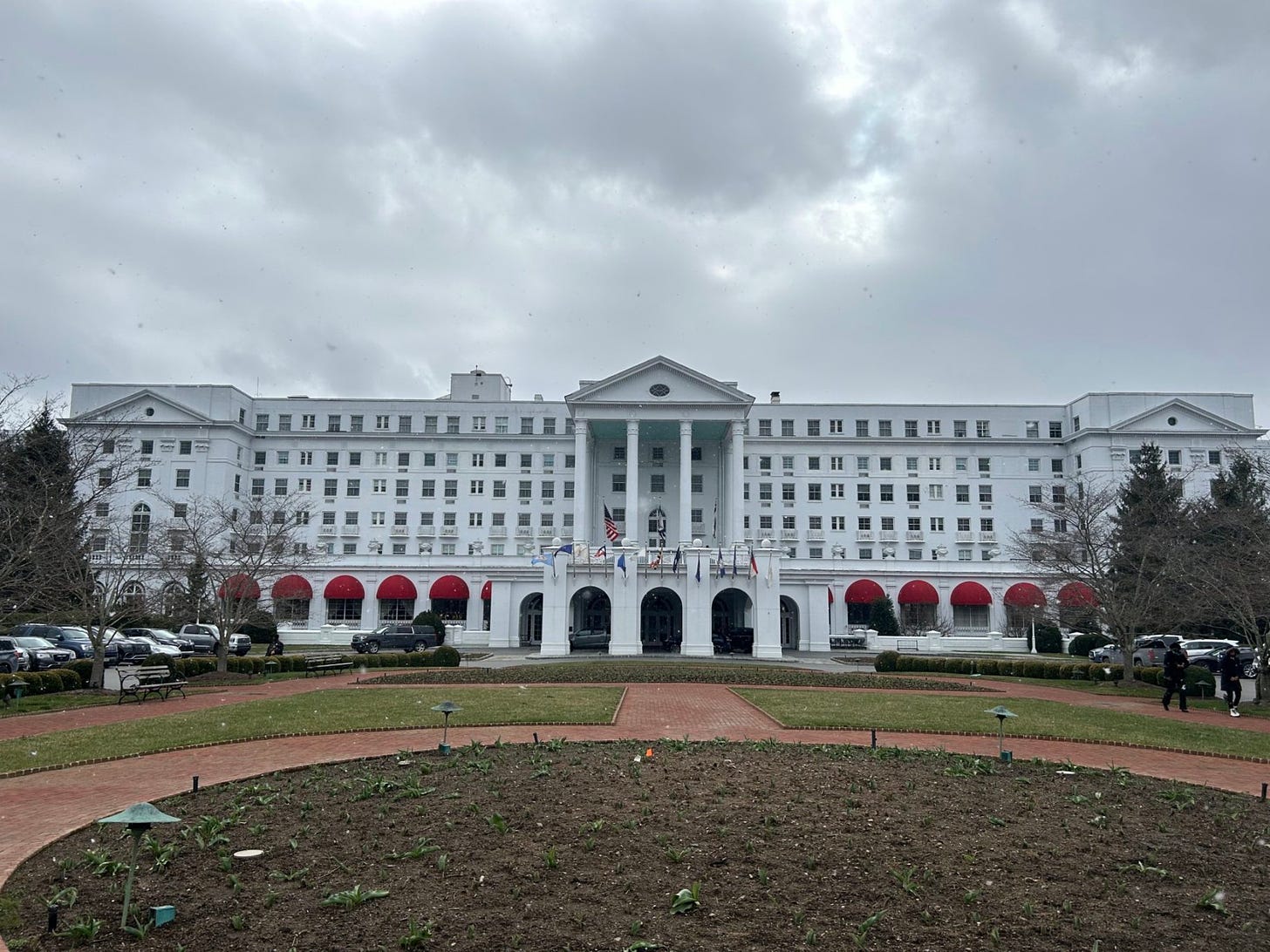
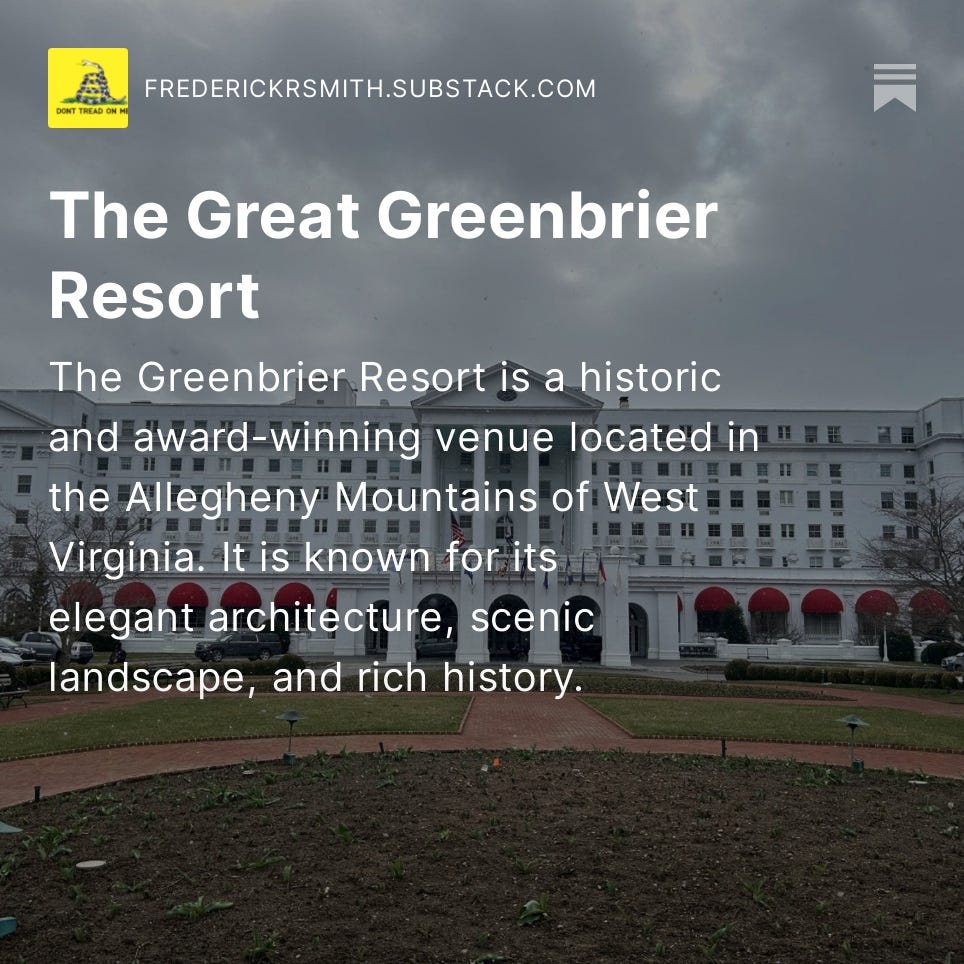
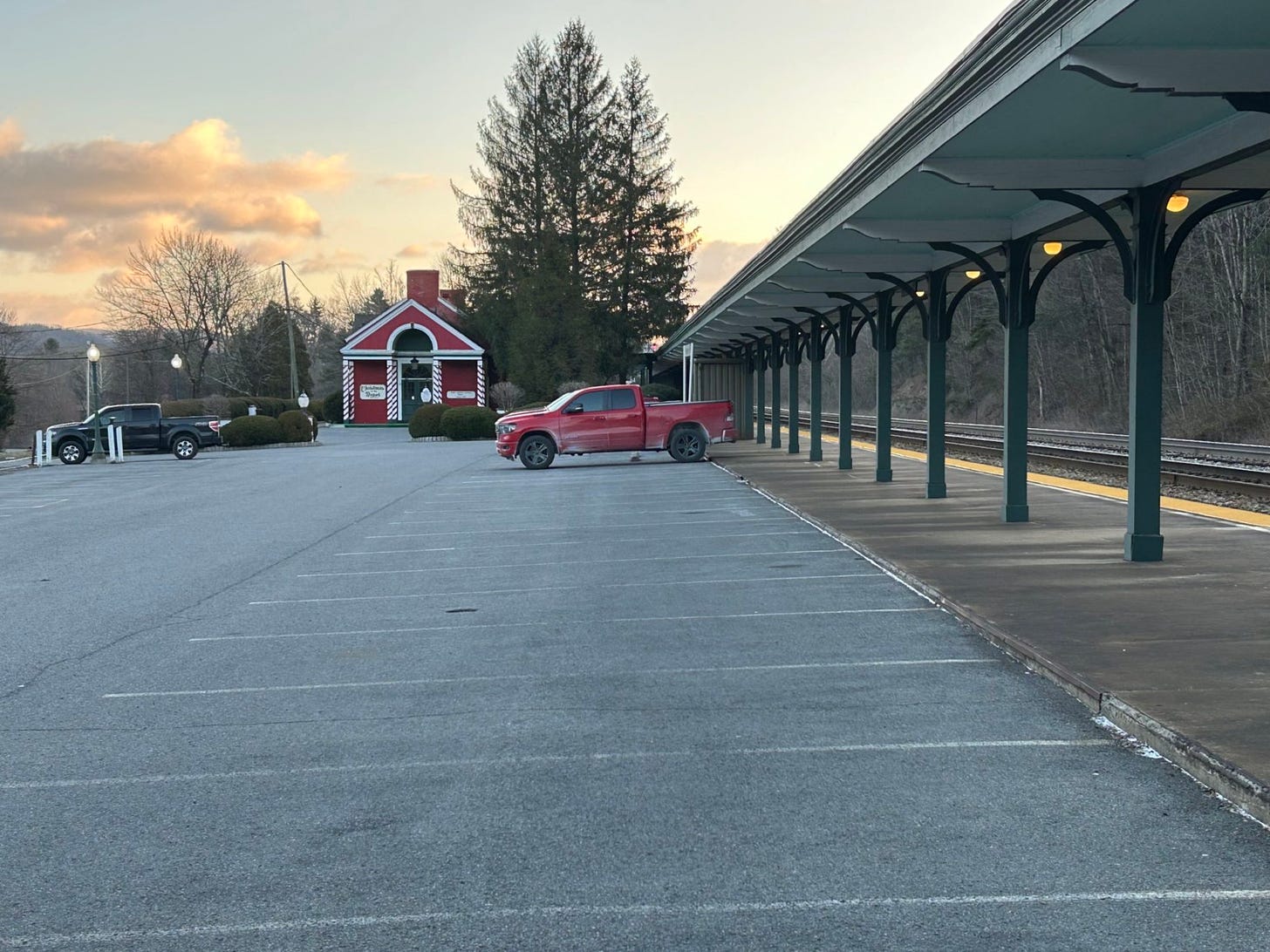
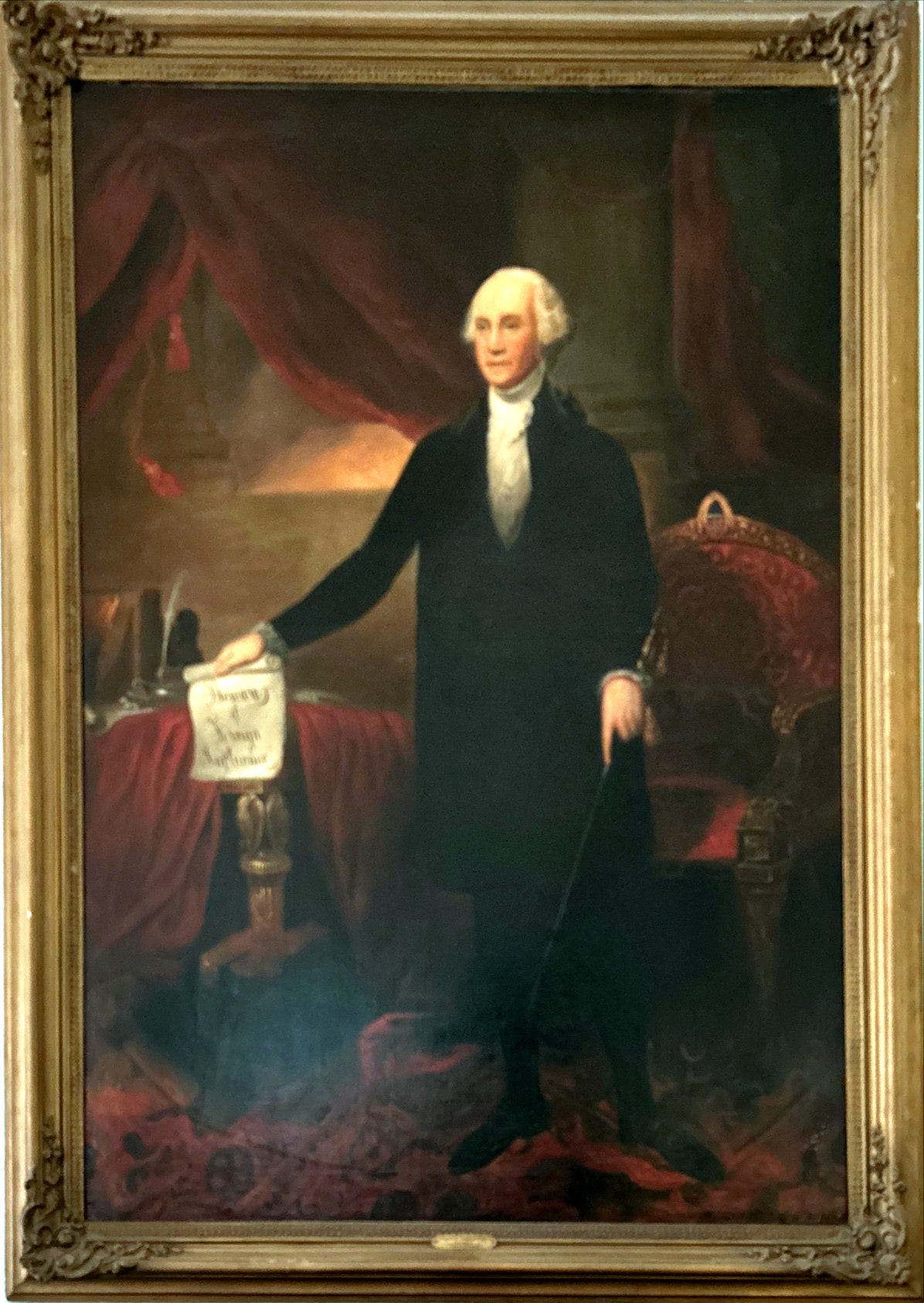







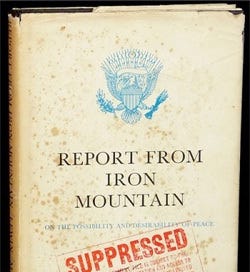

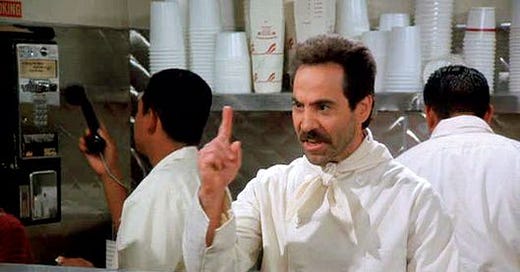

Awesome! Thanks for the explicit detail about a part of our American history also. While living back east, did not do too much traveling into West Virginia. Too bad.
It's beautiful.